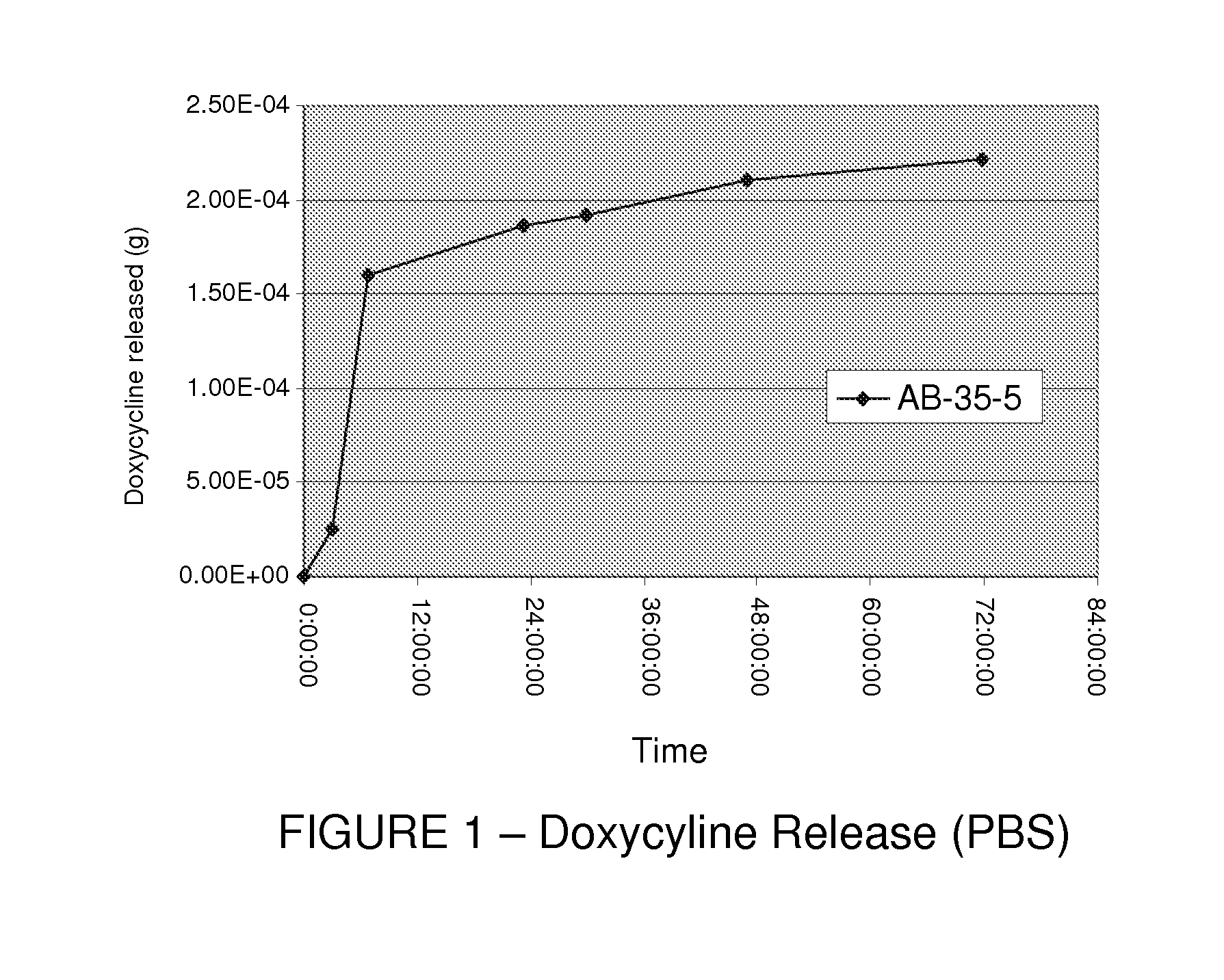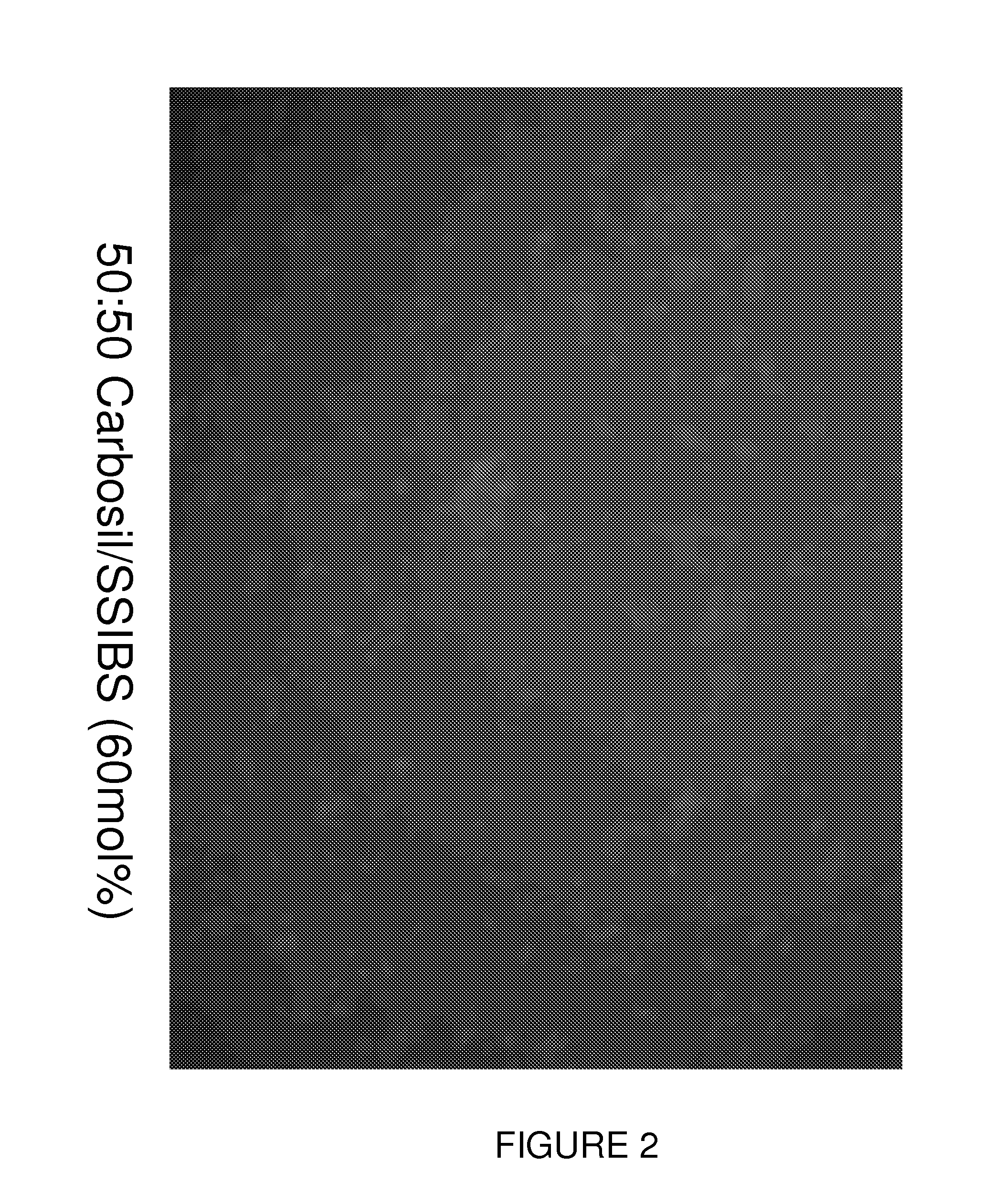Stable and compatible polymer blends
a technology of polymer blends and polymer blends, applied in the field of blended materials, can solve the problems of affecting the morphology of the blended product, the inability to thermodynamically stabilize the immiscible polymer blend, and the superior properties of the individual components
- Summary
- Abstract
- Description
- Claims
- Application Information
AI Technical Summary
Benefits of technology
Problems solved by technology
Method used
Image
Examples
example 1
Blending SSIBS with TPU
[0144]Sulfonated Styrene-Isobutylene-Styrene (SSIBS) polymer solutions (9 to 15% solid) were prepared. SSIBS product varied in sulfonation levels from 30 to 65 mol %.
[0145]Thermoplastic Polyurethane (TPU) (medical grade, Noveon) solutions were prepared (9% solid) by dissolving the TPU in tetrahydrofuran (THF) and were utilized to blend with the SSIBS solutions. The TPUs utilized were:
1. Tecophilic® hydrophilic aliphatic polyether-based TPU (high moisture absorption).
2. Tecoflex® aliphatic polyether-based TPU.
3. Carbothanealiphatic polycarbonate-based polyurethane.
4. Tecoplast® aromatic polyether-based TPU.
[0146]Bionate® polycarbonate urethane from the Polymer Technology Group, Inc. was also prepared (6.7% solid) by dissolving in DMAC (N,N-dimethylacetamide).
[0147]The following polymer blends were produced utilizing the above constituents:
A. Blend 56 mol % SSIBS / Tecophilic® in 50 / 50 by weight: Tecophilic® / THF solution (11 g, 9% solids) was added to the SSIBS po...
example 2
Blending SSIBS with Silicon Urethane Copolymers
[0148]SSIBS polymer solutions (9 to 15% solids) were prepared with varying sulfonation levels (30-65 mol %). Two silicone urethane copolymers (PurSil™ and CarboSil™ from the Polymer Technology Group, Inc. were utilized in the experiments. PurSil™ is a silicone polyether urethane and CarboSil™ is a silicone polycarbonate urethane.
[0149]The silicone urethane copolymer / DMAC solutions (7 to 9%) were prepared by dissolving the polymer resin in DMAC. The following blends were prepared: (Note: THF can be used as well as the solvent)
a. Blend: 50 mol % SSIBS / PurSil™ 50 / 50 by weight: PurSil™ / DMAC solution (44 g, 9% solids) was added to the SSIBS polymer solution (31.7 g, 12.6. % solids, 50 mol % sulfonation) by way of pipette while stirring and continual stirring overnight at 40° C. A homogenous solution resulted and a clear, transparent membrane was obtained following casting.
b. Blend: 50 mol % SSIBS / CarboSil™ 50 / 50 by weight: CarboSil™ / DMAC sol...
example 3
Cast Membrane of Blend SSIBS with TPUs and SSIBS with Silicone Urethane Copolymers
[0150]The above polymer blended solutions were slot cast onto silicone-coated polyester release liners on heated vacuum assisted casting tables with different blade settings. Membranes of different thickness resulted. The membranes were dried to remove solvent in a lab fume hood.
[0151]The prepared membranes were evaluated using a routine moisture transfer test based on DI water uptake at room temperature for 3 and 24 hours as well as total mass (moisture & ion) uptake in 0.9% saline solution at 50° C. for 3 and 24 hours. The results of these tests are detailed in Table 1.
TABLE 1SSIBS-Polyurethane total water absorbance data (0.9% saline, 50° C.)% massFormulationuptake @ 3 hours56 mol % SO3H SSIBS18756 mol % SO3H SSIBS:Tecophilic ® (50:50)15356 mol % SO3H SSIBS:Tecoflex ® (50:50)17456 mol % SO3H SSIBS:Carbothane ® (50:50)12356 mol % SO3H SSIBS:Tecoplast ® (OP) (50:50)11056 mol % SO3H SSIBS:Tecoplast ® (...
PUM
| Property | Measurement | Unit |
|---|---|---|
| melting point | aaaaa | aaaaa |
| mol % | aaaaa | aaaaa |
| mol % | aaaaa | aaaaa |
Abstract
Description
Claims
Application Information
 Login to View More
Login to View More - R&D
- Intellectual Property
- Life Sciences
- Materials
- Tech Scout
- Unparalleled Data Quality
- Higher Quality Content
- 60% Fewer Hallucinations
Browse by: Latest US Patents, China's latest patents, Technical Efficacy Thesaurus, Application Domain, Technology Topic, Popular Technical Reports.
© 2025 PatSnap. All rights reserved.Legal|Privacy policy|Modern Slavery Act Transparency Statement|Sitemap|About US| Contact US: help@patsnap.com



